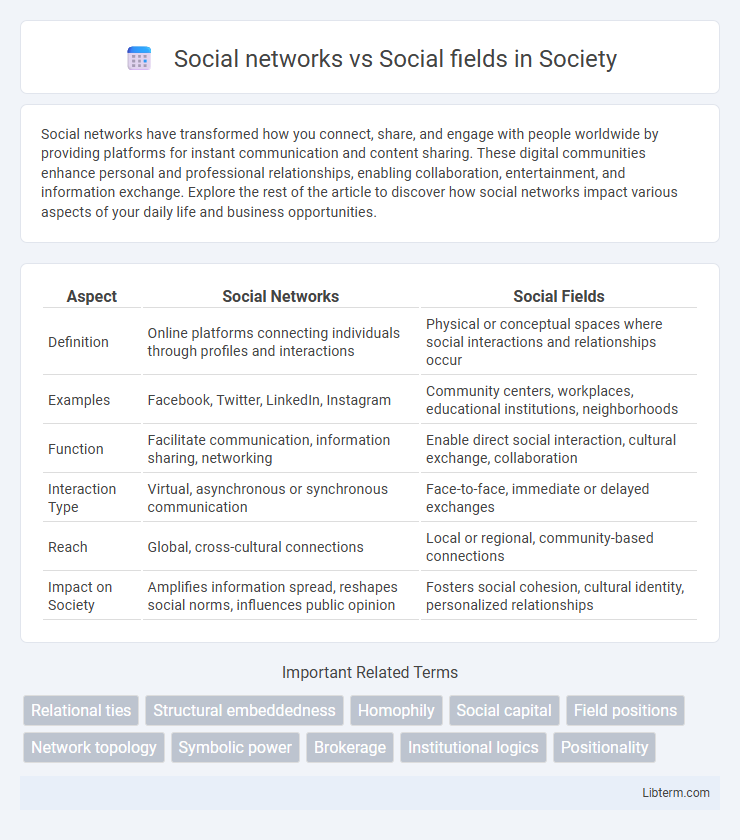Social networks have transformed how you connect, share, and engage with people worldwide by providing platforms for instant communication and content sharing. These digital communities enhance personal and professional relationships, enabling collaboration, entertainment, and information exchange. Explore the rest of the article to discover how social networks impact various aspects of your daily life and business opportunities.
Table of Comparison
| Aspect | Social Networks | Social Fields |
|---|---|---|
| Definition | Online platforms connecting individuals through profiles and interactions | Physical or conceptual spaces where social interactions and relationships occur |
| Examples | Facebook, Twitter, LinkedIn, Instagram | Community centers, workplaces, educational institutions, neighborhoods |
| Function | Facilitate communication, information sharing, networking | Enable direct social interaction, cultural exchange, collaboration |
| Interaction Type | Virtual, asynchronous or synchronous communication | Face-to-face, immediate or delayed exchanges |
| Reach | Global, cross-cultural connections | Local or regional, community-based connections |
| Impact on Society | Amplifies information spread, reshapes social norms, influences public opinion | Fosters social cohesion, cultural identity, personalized relationships |
Understanding Social Networks
Understanding social networks involves analyzing nodes as individuals or organizations and edges as relationships or interactions, providing insights into patterns of communication, influence, and resource flow. Social networks emphasize the connections and structure between actors, enabling measurement of centrality, cohesion, and network dynamics. This contrasts with social fields, which focus on broader social contexts and power relations shaped by cultural, economic, and political factors.
Defining Social Fields
Social fields are structured spaces of social relations shaped by power dynamics, resources, and cultural capital within specific contexts, differentiating them from social networks that emphasize individual connections. Pierre Bourdieu's theory defines social fields as arenas where actors engage in struggles over positions and influence, governed by unique rules and norms. Understanding social fields highlights how collective social forces and institutional frameworks influence behavior beyond mere interpersonal links in social networks.
Key Differences Between Networks and Fields
Social networks emphasize direct interpersonal connections and interactions among individuals or groups, mapping explicit relationships such as friendships, collaborations, or communications. Social fields, in contrast, refer to broader social spaces influenced by power dynamics, cultural norms, and institutional structures that shape behaviors and positions within society. While networks analyze concrete ties and paths, fields highlight systemic forces and relational positions influencing social actions and opportunities.
Historical Evolution of Social Networks
The historical evolution of social networks traces back to early human societies where kinship and community ties formed the primary social fields shaping interactions. Over time, technological advancements such as the printing press, telegraph, and eventually the internet transformed these social fields into expansive digital social networks, facilitating global connectivity. Modern social networks leverage algorithms and big data to optimize user engagement, fundamentally altering the structure and dynamics of traditional social fields.
Theoretical Foundations of Social Fields
Social fields are conceptualized within Pierre Bourdieu's theoretical framework, emphasizing power relations and habitus that shape social positions beyond mere network connections. Unlike social networks, which map direct relationships and interactions between individuals or groups, social fields encompass structured spaces of social practices governed by rules and capital distributions. This distinction highlights that social fields provide a deeper analysis of societal dynamics by focusing on the underlying logics and power struggles within social environments.
Network Analysis vs. Field Theory
Network Analysis focuses on mapping and quantifying relationships and interactions among actors within social networks, emphasizing structural patterns and node connectivity. Field Theory examines the broader social spaces shaped by power relations and positions, analyzing how individual agents' actions are influenced by underlying social forces and capital distributions. Both approaches offer complementary insights, with Network Analysis providing detailed structural metrics while Field Theory contextualizes these within dynamic social hierarchies and domains.
Influence and Power in Networks and Fields
Social networks emphasize the influence of individual actors through direct connections and relational ties, facilitating power derived from access, control, and mobilization of resources within these links. Social fields, grounded in Bourdieu's theory, highlight structured social positions and power dynamics shaped by capital forms--economic, cultural, and social--operating within institutionalized contexts. Power in networks manifests through actionable relationships enabling strategic advantage, whereas in fields, power is embedded in hierarchical positions and the capacity to impose symbolic meanings and norms.
Practical Applications: Networks and Fields in Society
Social networks map individual and group connections, facilitating communication, information flow, and influence within communities, enhancing targeted marketing, political campaigns, and emergency response strategies. Social fields represent structured systems of power, norms, and resources that shape behavior and social positions across economic, educational, and cultural domains, guiding institutional decision-making and policy development. Combining insights from networks and fields enables more effective interventions in public health, urban planning, and social justice by understanding both relational ties and systemic frameworks.
Challenges in Studying Social Networks and Fields
Studying social networks faces challenges such as capturing dynamic interactions and managing vast, complex data structures that evolve over time. Social fields present difficulties in defining boundaries and identifying the influence of cultural, economic, and institutional factors on individual behavior. Both approaches require advanced analytical tools and interdisciplinary methods to accurately model social phenomena and address issues of scale and context.
Future Trends: Integrating Networks and Fields
Future trends in social dynamics emphasize integrating social networks and social fields to foster deeper relational and contextual understanding. Advances in AI and big data analytics enable seamless mapping of individual connections within broader socio-cultural fields, enhancing predictive accuracy for behavior and influence patterns. This integration supports adaptive platforms that balance personal interactions with structural influences, driving more nuanced social engagement and collaboration.
Social networks Infographic

 libterm.com
libterm.com